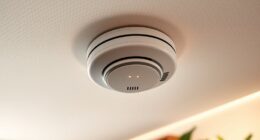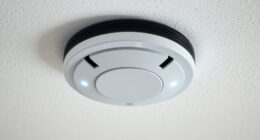To design effective multi-modal emergency alerts for stadiums and arenas, focus on capturing attention instantly through visual cues like flashing signs, auditory signals such as sirens, and tactile alerts like vibrating wristbands. Keep messages clear, simple, and relevant to each situation. Use multiple channels to guarantee everyone receives the warning, including those with disabilities. Test your system regularly and refine it based on feedback. Stay with us to explore strategies for seamless, life-saving communication during emergencies.
Key Takeaways
- Integrate visual, auditory, and tactile alerts to ensure message reach across diverse audience needs.
- Customize messages based on specific emergencies and audience demographics for relevance and clarity.
- Use clear, simple language with bold visuals and calm audio to prevent confusion and panic.
- Test multi-modal systems regularly through drills and gather feedback to optimize alert effectiveness.
- Incorporate technology like LED displays, sirens, and vibrating devices for comprehensive, layered communication.

Have you ever wondered what makes an emergency alert truly effective? It’s not just about delivering a message—it’s about capturing attention quickly and ensuring everyone understands what to do next. When designing multi-modal emergency alerts for stadiums and arenas, you need to focus on how your message engages the audience immediately. Audience engagement is essential because large crowds can be distracted or overwhelmed, making it easy for a critical message to go unnoticed. To combat this, your alerts should be designed to cut through the noise, grab attention instantly, and motivate swift action. Incorporating alert customization helps you tailor messages to specific situations and audiences. For example, a fire alert might emphasize evacuation routes, while a severe weather warning could provide shelter instructions. Customization ensures that the message remains relevant, clear, and effective for different scenarios.
Effective emergency alerts quickly capture attention, engage audiences, and tailor messages for clarity and action during crises.
Using multiple communication channels—visual, auditory, and sometimes even tactile—can greatly improve the reach and impact of your alerts. Visual alerts, like flashing digital signs or LED displays, are essential because they capture attention even if attendees are distracted or engrossed in the event. Auditory alerts, such as sirens or loudspeaker announcements, ensure that even those who might miss visual cues get the message. Some venues also implement tactile alerts, like vibrating wristbands or seat vibrations, to reach individuals with hearing impairments or in noisy environments. By integrating these modalities, you create a thorough alert system that maximizes audience engagement, regardless of the situation.
Another key aspect is the clarity and simplicity of your message. When designing multi-modal alerts, keep language straightforward and instructions concise. People need to understand what’s happening and what they should do within seconds. Use large fonts, bold colors, and clear icons to enhance visual communication, and speak in a calm, authoritative tone in auditory messages. The goal is to eliminate confusion and prevent panic, so your alerts should be easy to comprehend and act upon. Additionally, considering projector technology and how it can be used to display vital information quickly and clearly can significantly enhance visual communication during emergencies.
Finally, testing and refining your alert system is essential. Simulate different emergency scenarios to gauge how well your multi-modal alerts work and gather feedback from staff and even attendees. Adjustments might include tweaking message wording, improving visual displays, or adding new alert channels. When you design with audience engagement and alert customization at the forefront, you greatly improve your chances of keeping everyone safe and informed during a crisis. Your proactive approach ensures that your emergency alerts are not just heard or seen but truly effective in guiding people to safety.
Frequently Asked Questions
How Do Alerts Reach Spectators With Disabilities?
You make certain that alerts reach spectators with disabilities by using assistive technology like visual displays, tactile alerts, and audio announcements. Following accessibility standards, you incorporate multiple communication modes so everyone receives critical information promptly. You also consider hearing or vision impairments, making sure alerts are clear and accessible through various methods. This approach guarantees that all spectators stay informed and safe during emergencies, regardless of their disabilities.
What Are the Costs of Implementing Multi-Modal Alert Systems?
Think of the costs of implementing multi-modal alert systems as planting seeds for safety. A thorough cost analysis helps you understand technology deployment expenses, including hardware, software, and training. While initial investments might seem steep, they’re an essential safety net for all spectators. You’ll need to balance these costs against long-term benefits, ensuring quick, effective communication during emergencies without breaking the bank.
How Do Alerts Differ for Various Types of Emergencies?
You’ll notice that alerts differ based on the emergency type, focusing on audience engagement and message clarity. For medical emergencies, alerts emphasize quick action and reassurance. Fire or security threats require clear evacuation instructions, while weather alerts highlight safety precautions. Tailoring messages guarantees your audience understands the severity and necessary response, reducing confusion and panic. Effective differentiation helps maintain safety and order during various emergency situations.
Can Alerts Be Customized for Different Stadium Events?
Yes, alerts can be customized for different stadium events by using event-specific messaging and audience segmentation. You can tailor the alerts to match the event’s nature, ensuring relevant information reaches the right groups. For example, during concerts, you might emphasize crowd control, while sports events could focus on safety procedures. This targeted approach improves communication effectiveness, keeps attendees informed, and enhances their overall safety experience.
What Training Is Needed for Staff to Manage Alerts Effectively?
They say knowledge is power, and that’s true for managing alerts. You need thorough staff training on emergency protocols to act swiftly and confidently. Practice drills and clear communication channels are essential. Staff should understand alert systems, their roles during emergencies, and how to assist guests. Regular updates keep everyone prepared, ensuring you’re ready to handle any situation calmly and effectively when it counts most.
Conclusion
By integrating multi-modal emergency alerts, you create a safety net that catches everyone in its web, no matter where they are. Your proactive approach transforms a crowded stadium from a potential chaos zone into a well-coordinated fortress of safety. Remember, in emergencies, clear communication is your guiding light, illuminating the path through darkness. When every second counts, your thoughtful design can be the difference between panic and peace—turning safety into your stadium’s strongest cheer.











